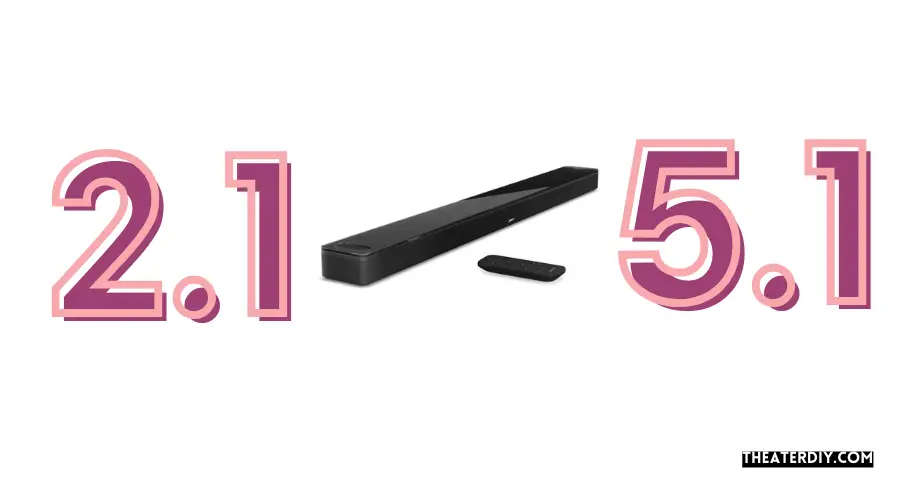Soundbar channels refer to the number of audio channels or speakers in a soundbar system. A 2.1 channel soundbar consists of two speakers and a subwoofer, while a 3.1 channel soundbar has three speakers and a subwoofer.
Demystifying Soundbar Channels: A Comprehensive Guide
These channels determine the level of audio immersion and surround sound experience provided by the soundbar. For a well-rounded investing in a soundbar can greatly enhance your audio experience while watching movies or listening to music. However, understanding soundbar channels is crucial in order to choose the right system that suits your needs.
With various options available in the market, such as 2. 1 channel and 3. 1 channel soundbars, it’s important to know the difference between them to make an informed decision. We will explain what soundbar channels mean and give you a clear understanding of the different channel configurations available, helping you choose the best soundbar for your entertainment setup.

Credit: news.samsung.com
Understanding Soundbar Channels
Soundbar channels refer to the number of audio channels a soundbar has, such as 2. 1, 5. 1, or 7. 1. These channels determine the level of surround sound and audio immersion you can expect from your soundbar setup.
Definition Of Soundbar Channels:
- Soundbar channels refer to the number of audio channels or speakers present in a soundbar system.
- The channels indicate how many speakers are used to create sound and the positioning of those speakers within the soundbar.
Importance Of Soundbar Channels For Audio Quality:
- The number of channels in a soundbar directly impacts the audio quality and immersive experience.
- More channels allow for better audio separation and create a more realistic and multi-dimensional soundstage.
- The additional channels can reproduce specific audio effects, such as surround sound, for a more engaging viewing or listening experience.
How Soundbar Channels Affect Sound Distribution:
- Soundbar channels determine how sound is distributed across the listening area.
- Different channels have specific roles in reproducing different aspects of audio, such as dialogue, music, or atmospheric sounds.
- Each channel works together harmoniously to create an immersive sound experience with precise localization of audio elements.
Examples Of Soundbar Channel Configurations:
- 2.1 channel: Two channels (left and right) for stereo sound and a separate subwoofer for bass.
- 5.1 channel: Five channels (front left, center, front right, rear left, and rear right) for surround sound, along with a subwoofer for enhanced bass.
- 7.1 channel: Seven channels (front left, center, front right, rear left, rear right, side left, and side right) for a more immersive surround sound experience.
- The larger the number of channels, the more spatially accurate and immersive the sound reproduction becomes.
Remember, the soundbar channels play a crucial role in delivering an exceptional audio experience, and understanding their significance will help you choose the right soundbar for your needs.
2.1 Vs 5.1 Soundbar Channels

For those wondering what soundbar channels mean, a 2. 1-channel soundbar is suitable for basic tv audio improvement, while a 5. 1 or 7. 1-channel soundbar provides a more immersive sound experience. Choose the right option for your desired level of immersion.
Explaining The Difference Between 2.1 And 5.1 Soundbar Channels:
A soundbar is a popular audio device that enhances the sound quality of your tv or home theater system. One important aspect to consider when choosing a soundbar is the number of channels it has. Channels refer to the number of speakers and subwoofers the soundbar has, and it greatly affects the overall audio experience.
The most common soundbar channel configurations are 2. 1 and 5. 1. Let’s take a closer look at the difference between these two options:
Pros And Cons Of A 2.1 Soundbar System:
A 2. 1 soundbar system consists of two speakers and one subwoofer. This configuration offers a significant improvement over standard tv speakers, providing a more immersive audio experience. Here are the pros and cons of a 2. 1 soundbar system:
- Enhanced audio quality: The addition of a subwoofer allows for deeper bass, making action scenes and music more impactful.
- Space-saving design: A 2.1 soundbar system is compact and can be easily placed in front of your tv or mounted on a wall, saving valuable space compared to traditional speaker setups.
- Easy setup: With only two speakers and one subwoofer, setting up a 2.1 soundbar system is relatively simple and hassle-free.
- Affordability: 2.1 soundbar systems are usually more affordable compared to higher channel configurations.
- Limited surround sound experience: While a 2.1 soundbar system provides an improved audio experience, it doesn’t offer the same level of surround sound as higher channel configurations like 5.1.
Pros And Cons Of A 5.1 Soundbar System:
A 5. 1 soundbar system consists of five speakers and one subwoofer, providing a more immersive surround sound experience. Here are the pros and cons of a 5. 1 soundbar system:
- Immersive surround sound: The additional speakers in a 5.1 soundbar system create a more immersive audio experience, allowing you to hear sound from different directions, providing a more realistic feel.
- Enhanced audio separation: With multiple speakers, a 5.1 soundbar system offers better sound separation, allowing you to discern individual sounds and details more accurately.
- Cinematic experience: Movies and games are enhanced with a 5.1 soundbar system, as it replicates the audio experience of a movie theater, immersing you in the action.
- More complex setup: Setting up a 5.1 soundbar system may require more effort due to the additional speakers and cables involved.
- Higher cost: Compared to a 2.1 soundbar system, a 5.1 configuration is typically more expensive due to the additional speakers and components.
The choice between a 2. 1 and 5. 1 soundbar system depends on your preferences, budget, and space constraints. If you want a more immersive surround sound experience and are willing to invest in a higher channel configuration, a 5.
1 soundbar system may be the right choice for you. However, if you are looking for an affordable and space-saving option that still provides enhanced audio quality, a 2. 1 soundbar system is a great choice. Choose the configuration that best suits your needs and enjoy an enhanced audio experience with your soundbar.
Choosing The Right Soundbar Channels

When it comes to soundbars, understanding the channels is crucial. A 2-channel soundbar is suitable for basic tv audio improvement, while a 5. 1 or 7. 1-channel soundbar provides a more immersive experience. Choose the right soundbar channels for the best audio performance.
Choosing The Right Soundbar Channels:
When it comes to selecting the right soundbar channels, there are a few factors to consider. Whether you’re watching movies, playing games, or listening to music, choosing the right soundbar channels can greatly enhance your audio experience. Here are some important factors to keep in mind:
- Room size and layout: The size and layout of your room play a crucial role in determining the number of soundbar channels you need. Larger rooms may benefit from soundbars with more channels to create a more immersive audio experience.
- Audio quality: Different soundbar channels offer varying levels of audio quality. Consider the audio quality you desire and choose a soundbar that meets your expectations.
- Surround sound capability: Some soundbars come with surround sound capability, allowing you to experience a more realistic audio experience. If you enjoy movies or gaming, choosing a soundbar with surround sound channels can greatly enhance your immersion.
- Connectivity options: Depending on your setup, you may need specific connectivity options. Consider the devices you want to connect to your soundbar and ensure that it has the necessary inputs and outputs.
- Personal preferences: Ultimately, your personal preferences play a significant role in choosing the right soundbar channels. Consider the types of content you consume and the audio experience you want to achieve.
Recommended soundbar channels for different viewing environments:
- 2.1 soundbar channels: This setup includes two front channels for stereo sound and a dedicated subwoofer for improved bass response. It’s suitable for small to medium-sized rooms or when space is limited.
- 3.1 soundbar channels: In addition to the two front channels and a subwoofer, a 3.1 setup includes a center channel for clearer dialogue. It’s great for home theaters or larger living rooms where dialogue clarity is important.
- 5.1 soundbar channels: This setup adds two rear channels to the 3.1 configuration, creating a true surround sound experience. It’s ideal for larger rooms and provides a more immersive audio experience for movies and gaming.
- 7.1 soundbar channels: For the ultimate surround sound experience, a 7.1 setup includes two additional side channels. It’s perfect for dedicated home theaters and enthusiasts who want the most immersive audio possible.
Budget considerations for different soundbar channel options:
- 2.1 soundbar channels: 2.1 setups are generally more affordable compared to higher channel configurations. They offer a solid audio experience without breaking the bank.
- 3.1 soundbar channels: Adding a center channel to the setup does increase the cost slightly, but it significantly improves dialogue clarity. It’s a good middle-ground option for those who want enhanced audio without a hefty price tag.
- 5.1 soundbar channels: As the number of channels increases, so does the price. 5.1 setups provide a truly immersive audio experience, but they come at a higher cost compared to 2.1 or 3.1 setups.
- 7.1 soundbar channels: 7.1 setups are the most expensive due to the increased number of channels and advanced technologies. They are ideal for enthusiasts who want the best surround sound experience possible, but they may not be budget-friendly for everyone.
Remember to consider your budget, room size, desired audio quality, and personal preferences when choosing the right soundbar channels. Each option has its own benefits and price considerations, so it’s essential to find the perfect balance that suits your needs.
Frequently Asked Questions

What Is The Best Number Of Channels For A Soundbar?
A 2-channel soundbar should be sufficient for improving the audio on your tv. However, for a more immersive experience, consider a 5. 1 or 7. 1 channel soundbar.
What Is The Difference Between 2.1 Channel And 3.1 Channel Soundbar?
2. 1 channel soundbar consists of two speakers and one subwoofer, while a 3. 1 channel soundbar has three speakers and one subwoofer. The number before the decimal point indicates the number of main speakers, and the number after the decimal point represents the presence of a subwoofer.
In a 2. 1 channel soundbar, the two speakers produce left and right stereo audio, while the subwoofer enhances the low-frequency bass sounds. On the other hand, a 3. 1 channel soundbar adds a center speaker to the left and right stereo speakers, enhancing the clarity and dialogues in movies and tv shows.
This additional speaker helps provide a more immersive and balanced sound experience, especially for content that relies heavily on dialogues. So, if you’re looking for a more focused and detailed audio experience, a 3. 1 channel soundbar is a better choice compared to a 2.
1 channel soundbar.
What Is The Difference Between 2.1 Ch And 5.1 Ch?
A 2. 1 channel soundbar consists of two main speakers (left and right) and a subwoofer, while a 5. 1 channel soundbar adds two additional speakers (rear left and rear right). The “2. 1” and “5. 1” refer to the number of speakers and subwoofers in the sound system.
A 2. 1 channel soundbar offers a basic audio improvement for your tv, while a 5. 1 channel soundbar provides a more immersive and surround sound experience. The additional rear speakers in a 5. 1 channel setup create a more spatial and realistic audio experience, making you feel like you’re in the center of the action.
If you’re looking for a more advanced and movie theater-like audio experience, a 5. 1 channel soundbar would be the better option.
What Does 2.1 Channels On A Soundbar Mean?
A 2. 1 channel soundbar refers to a sound system that has two main speakers and one subwoofer. The two main speakers produce the left and right audio channels, while the subwoofer enhances the bass frequencies. This configuration provides a more immersive audio experience compared to a basic 2-channel soundbar.
On the other hand, a 3. 1 channel soundbar has three main speakers and one subwoofer. The additional center speaker in the 3. 1 setup is responsible for producing clearer and more distinct dialogues and vocals. This makes it ideal for watching movies or tv shows where dialogue clarity is crucial.
Overall, the number before the decimal point indicates the number of main speakers, while the number after the decimal point represents the presence of a dedicated subwoofer.
Conclusion
Provides an additional center channel speaker, which enhances dialogue clarity and overall sound quality. This means that with a 3. 1 channel soundbar, you’ll experience more balanced and immersive audio, especially when watching movies or tv shows with dialogue-heavy scenes.
On the other hand, a 2. 1 channel soundbar consists of two speakers and a subwoofer. While it still delivers an upgraded audio experience compared to your tv’s built-in speakers, it may not have the same level of clarity and depth as a 3.
1 channel soundbar. When choosing between these soundbar channels, it ultimately depends on your preferences and viewing habits. If you prioritize better dialogue clarity and a more cinematic experience, a 3. 1 channel soundbar is the way to go. However, if you’re looking for a more budget-friendly option without sacrificing too much audio quality, a 2.
1 channel soundbar will still greatly enhance your tv’s sound. Understanding soundbar channels is crucial in making an informed decision when purchasing a soundbar. By considering factors like the type of audio you consume and your budget, you can choose the right soundbar channel configuration that suits your needs and elevates your audio experience.


